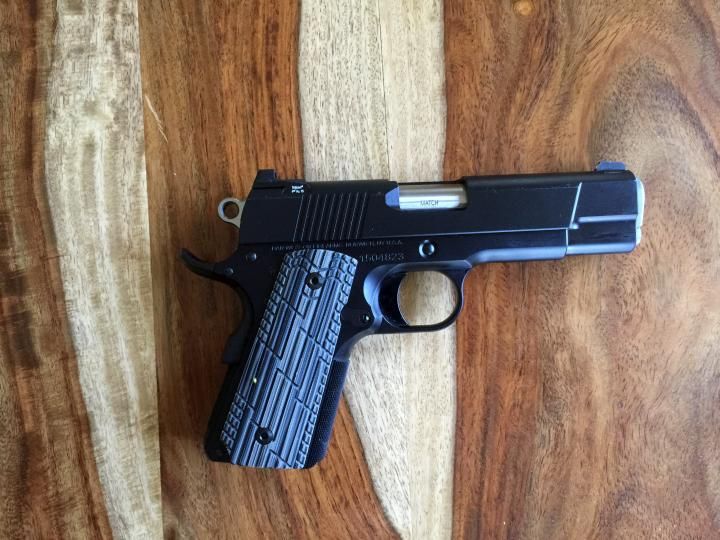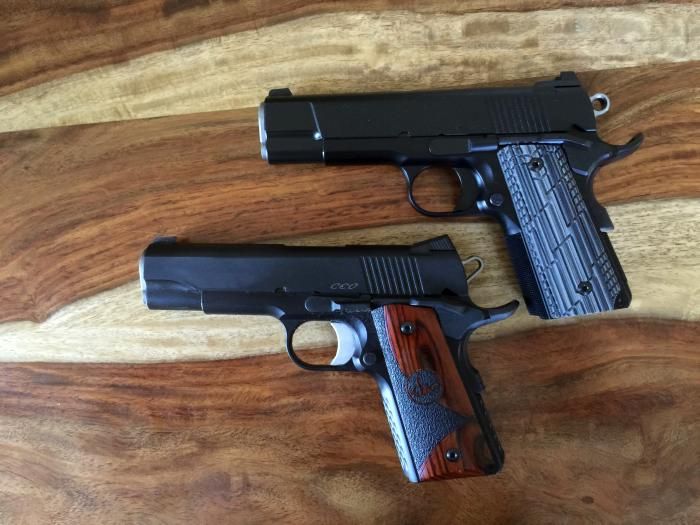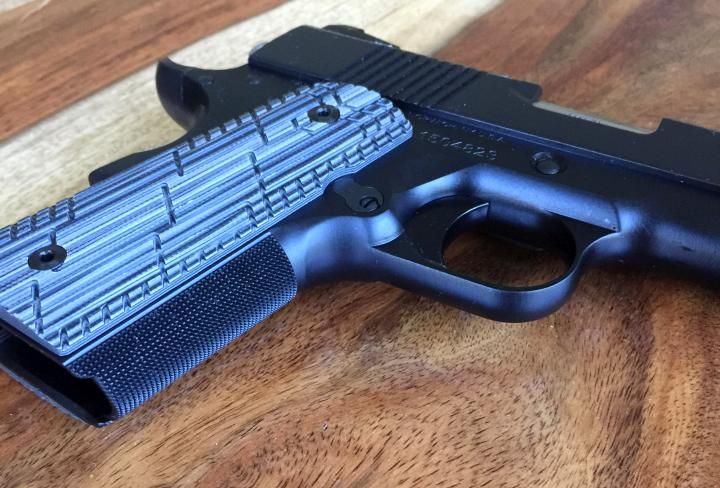This review is a bit long, so I've posted it into two parts. The first is about the Dan Wesson Valkyrie in general. The last is about the specific pistol I recently acquired.
PART 1
In Norse mythology, the Valkyries were beautiful but fierce shield maidens who rode to the battlefield and chose the bravest of the fallen to reside in Valhalla. There, between feasting and drinking, the warriors trained for the Norse version of Armageddon. Some myths recount that Valkyries sometimes helped protect warriors they favored. One can almost hear Wagner playing in the background. With this bit of lore, we see why Dan Wesson chose the name Valkyrie for its cross between the CCO and the ECO. The Dan Wesson Valkyrie is well-suited in the role of a beautiful, but deadly protector.

The Valkyrie is the same size as the CCO — a Commander length barrel (4.25 inches) and Officer length grip frame (one less round than the Government model 1911). The ECO has both the Officer length grip frame and the Officer length barrel (3.5 inches). I’m not a big fan of 1911s with barrels shorter than 4.25 inches even though I own one. IMO, they are just harder to make reliable. So, for me, the CCO/Valkyrie sized 1911 is the perfect concealed carry size. The CCO and Valkyrie each also sport an aluminum frame which shaves several ounces off the weight of the pistols.

So, how do the CCO and Valkyrie differ? Let’s start with the slide. The Valkyrie comes with “carry cuts” or “Hi-Power cuts” to the front of the slide. This rakish, narrowing of the slide helps when re-holstering, especially when carrying in an inside the waistband holster. That’s the justification. The real reason for is that it just looks really nice!. There is a ball cut there which is a subtle, but nice touch.

Both pistols have night sights. The CCO has a Novak-style rear sight with two dots and the Valkyrie has a ledge type rear sight with one dot (made by Trijicon). The ledge style rear sight is trendy because it allows easier slide manipulation with one hand out of commission.

Moving down to the frame area. Both pistols come with slim grip panels. The CCO panels are done in a handsome, partially stippled wood. The Valkyrie sports aggressive grips made from G10. The grips complement the 25- LPI checkering on the front of the grip frame and on the mainspring housing. The CCO has a chainlink type of stippling. While these suffice, it’s also hard to argue with the extra grip that checkering gives.

The frame of the Valkyrie is subtlety cut just a bit higher in the trigger area than on the CCO. This enables a higher hold and gives a bit more recoil control. Both pistols also have a rounded butt frame which doesn’t sound like a big deal, but is. A covering garment is much less likely to cling to the frame here, making the guns more concealable. I have a couple of bobtail commander sized pistols with the slightly longer grip frame and I think the rounded butt of the CCO/Valkyrie makes it conceal a bit easier. I have a couple of other 1911s the same size without the rounded butt and their concealibility is a toss up with the bobtailed guns.
Both pistols also use a standard guide rod/recoil spring setup along with a barrel with a bushing. The bushing on each are thicker than normal which may add a little in durability but which adds even more to the looks of the pistols. The Valkyrie has a flush cut, reverse crowned barrel.
The Valkyrie has a recessed slide stop. The CCO does not. For me, this is purely cosmetic. In fact, the non-recessed slide stop is more practical for me. It’s just a bit harder to remove the recessed slide stop. I understand it may have actual benefit for lefties to prevent their strong side thumb from pushing against the slide stop.

One note, DW specifically warns against using solvent based cleaners on anything except the barrel as damage could result to the finish of the gun. From reports I’ve seen, the near black finish can be turned grayish in color. DW specifically mentions Kroil as a gun barrel cleaner that is safe for use on their Duty Finish. If you use a solvent to clean the barrel, DW suggests using an oil based cleaner which is safe on polymers for the rest of the gun.
PART 1
In Norse mythology, the Valkyries were beautiful but fierce shield maidens who rode to the battlefield and chose the bravest of the fallen to reside in Valhalla. There, between feasting and drinking, the warriors trained for the Norse version of Armageddon. Some myths recount that Valkyries sometimes helped protect warriors they favored. One can almost hear Wagner playing in the background. With this bit of lore, we see why Dan Wesson chose the name Valkyrie for its cross between the CCO and the ECO. The Dan Wesson Valkyrie is well-suited in the role of a beautiful, but deadly protector.

The Valkyrie is the same size as the CCO — a Commander length barrel (4.25 inches) and Officer length grip frame (one less round than the Government model 1911). The ECO has both the Officer length grip frame and the Officer length barrel (3.5 inches). I’m not a big fan of 1911s with barrels shorter than 4.25 inches even though I own one. IMO, they are just harder to make reliable. So, for me, the CCO/Valkyrie sized 1911 is the perfect concealed carry size. The CCO and Valkyrie each also sport an aluminum frame which shaves several ounces off the weight of the pistols.

So, how do the CCO and Valkyrie differ? Let’s start with the slide. The Valkyrie comes with “carry cuts” or “Hi-Power cuts” to the front of the slide. This rakish, narrowing of the slide helps when re-holstering, especially when carrying in an inside the waistband holster. That’s the justification. The real reason for is that it just looks really nice!. There is a ball cut there which is a subtle, but nice touch.

Both pistols have night sights. The CCO has a Novak-style rear sight with two dots and the Valkyrie has a ledge type rear sight with one dot (made by Trijicon). The ledge style rear sight is trendy because it allows easier slide manipulation with one hand out of commission.

Moving down to the frame area. Both pistols come with slim grip panels. The CCO panels are done in a handsome, partially stippled wood. The Valkyrie sports aggressive grips made from G10. The grips complement the 25- LPI checkering on the front of the grip frame and on the mainspring housing. The CCO has a chainlink type of stippling. While these suffice, it’s also hard to argue with the extra grip that checkering gives.

The frame of the Valkyrie is subtlety cut just a bit higher in the trigger area than on the CCO. This enables a higher hold and gives a bit more recoil control. Both pistols also have a rounded butt frame which doesn’t sound like a big deal, but is. A covering garment is much less likely to cling to the frame here, making the guns more concealable. I have a couple of bobtail commander sized pistols with the slightly longer grip frame and I think the rounded butt of the CCO/Valkyrie makes it conceal a bit easier. I have a couple of other 1911s the same size without the rounded butt and their concealibility is a toss up with the bobtailed guns.
Both pistols also use a standard guide rod/recoil spring setup along with a barrel with a bushing. The bushing on each are thicker than normal which may add a little in durability but which adds even more to the looks of the pistols. The Valkyrie has a flush cut, reverse crowned barrel.
The Valkyrie has a recessed slide stop. The CCO does not. For me, this is purely cosmetic. In fact, the non-recessed slide stop is more practical for me. It’s just a bit harder to remove the recessed slide stop. I understand it may have actual benefit for lefties to prevent their strong side thumb from pushing against the slide stop.

One note, DW specifically warns against using solvent based cleaners on anything except the barrel as damage could result to the finish of the gun. From reports I’ve seen, the near black finish can be turned grayish in color. DW specifically mentions Kroil as a gun barrel cleaner that is safe for use on their Duty Finish. If you use a solvent to clean the barrel, DW suggests using an oil based cleaner which is safe on polymers for the rest of the gun.
Last edited:
